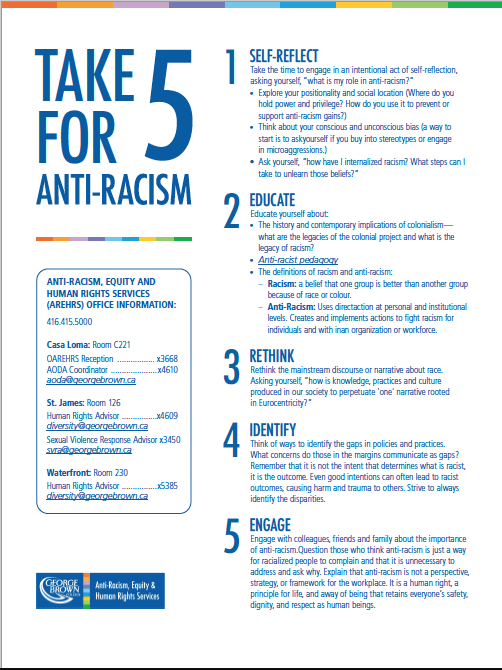What is Take 5 for Anti-Racism?
Take 5 for Anti-Racism is a simple-to-use resource that guides the user through five simple steps to engage in Anti-Racism. This tool can be used by anyone: those who are versed in the anti-racism dialogue/practice, and those who are new to the topic. This resource is meant to support, engage and, most importantly, have us all reflect on the best ways we can personally enter the dialogue and practice of Anti-Racism. This engagement looks different for everyone.
Learn more about different forms of racism and what the college is doing to address them.
How can you take 5?
1. Self-Reflect
Take the time to engage in an intentional act of self-reflection, asking yourself, "what is my role in antiracism?" Explore your positionality and social location (Where do you hold power and privilege? How do you use it to prevent or support antiracism gains?) Think about your conscious and unconscious bias (a way to start is to ask yourself if you buy into stereotypes or engage in microaggressions.) Ask yourself, "how have I internalized racism? What steps can I take to unlearn those beliefs?"
2. Educate
Educate yourself about:
- The history and contemporary implications of colonialism - what are the legacies of the colonial project and what is the legacy of racism?
- Anti-racist pedagogy
- The definitions of racism and anti-racism
- Racism - a belief that one group is better than another group because of race or colour.
- Anti-Racism - uses direct action at personal and institutional levels. Creates and implements actions to fight racism for individuals and within an organization or workforce.
3. Rethink
Rethink the mainstream discourse or narrative about race. Ask yourself, "how is knowledge, practices and culture produced in our society to perpetuate “one” narrative rooted in Eurocentricity?"
4. Identify
Think of ways to identify the gaps in policies and practices. What concerns do those in the margins communicate as gaps? Remember that it is not the intent that determines what is racist, it is the outcome. Even good intentions can often lead to racist outcomes, causing harm and trauma to others. Strive to always identify the disparities.
5. Engage
Engage with colleagues, friends and family about the importance of antiracism. Question those who think antiracism is just a way for racialized people to complain and that it is unnecessary to address and ask why. Explain that antiracism is not a perspective, strategy, or framework for the workplace. It is a human right, a principle for life, and a way of being that retains everyone’s safety, dignity, and respect as human beings.

